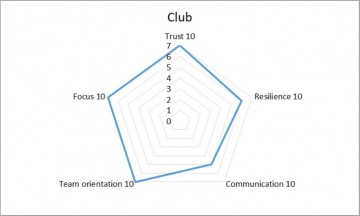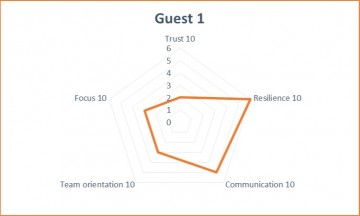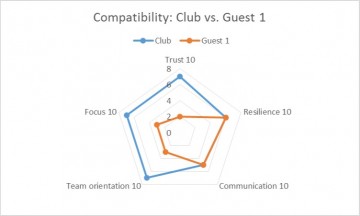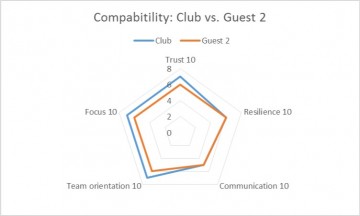Over the last few weeks, we’ve looked at the five components needed to build a healthy framework for negotiating agreements:
Trust
Resiliency
Communication
Team Orientation
Focus
For illustration, I’ve applied these components to a particular kind of business advisory group—3to5 Clubs.
Last week we explored the last two of these five elements foundational to building great partnerships. This week we’ll look at how these components of team orientation work in 3to5 Clubs and how they can be applied to any business partnerships of two or more.
So, what do we do with this great framework?
Returning to the premise of the 3to5 Club as the business advisory group, let’s suppose a Club has developed a Club profile of how their members perceive themselves across these five attributes. The Club radar chart looks like this:

Now let’s suppose you have an applicant–a prospective partner–rate and share his ranking of these five attributes. His chart looks like this:

Next, let’s suppose the Club then assesses how well that guest might fit with Club values. Since perception is what matters most, the larger the gap between how the Club values these attributes vs. how the applicant views himself is the most important information to assess. The bigger the gap between their perceived values, the less potential compatibility there is between the Club and the prospective partner/member.
Let’s compare the Club vs. Guest 1. Note that for the attributes of Trust, Team Orientation, and Focus there are large gaps. Guest 1 will likely not fit well in the Club. This would likely be a rocky “partnership.”

For contrast, suppose there’s a Guest 2; compare his self-perception in relation to the Club’s. The two patterns look very similar. They likely predict a strong match between Club and Guest 2’s values, resulting in a much higher probability for a good partnership to emerge.

This model is easily applied to two or more potential partners. Each can do a self-assessment across these five attributes. The most valuable part of this assessment is the dialogue that can emerge from explaining those differences in perception. It could be that one partner rates every attribute very high (or very low) and the gap is one of scale. On the other hand, irregular gaps could be the source of either productive dialogue or harmful friction.
Toolkit:
Regardless of which mastermind group or business advisory club you belong to, consider re-reading the above, doing the exercise and seeing where it goes. Thank you for sharing your insights below.



